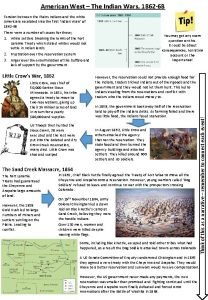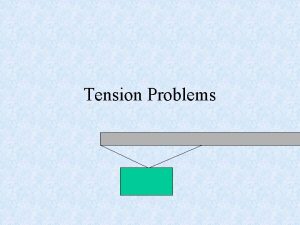American West The Indian Wars 1862 68 Tension


- Slides: 2

American West – The Indian Wars, 1862 -68 Tension between the Plains Indians and the white Americans escalated into the first ‘Indian Wars’ of 1862 -68 There were a number of causes for these; 1. White settlers breaking the terms of the Fort Laramie Treaty which stated whites would not settle in Indian lands 2. Frustration over the reservation system 3. Anger over the extermination of the buffalo and lack of support by the government. Little Crow, was chief of 50, 000 Santee Sioux Minnesota. In 1851, his tribe agreed a treaty to move to two reservations, giving up their 24 million acres of land in return for a yearly $80, 000 and supplies. US Troops then hunted the Sioux down, 38 were executed and the rest were put into the isolated and dry Crow Creek reservation, many died. Little Crow was shot and scalped However, the reservation could not provide enough food for the Indians, traders tricked Indians out of their goods and the government and they would not let them hunt. This led to Indians stealing from the reservations and conflict with traders who the Indians owed money to. In 1858, the government took away half of the reservation land to pay off the Indians debts. As farming failed and there was little food, the Indians faced starvation. In August 1862, Little Crow and others attacked the agency that ran the reservation. They stole food and then burned the agency buildings and attacked settlers. They killed around 600 settlers and US soldiers. The Sand Creek Massacre, 1864 The Fort Laramie Treaty had guaranteed the Cheyenne and Arapaho large amounts of land. However, the 1858 Gold Rush led to large numbers of miners and settlers settling on the Plains. Leading to conflict. In 1861, chief Black Kettle finally agreed the Treaty of Fort Wise to move all the Cheyenne and Arapaho onto a reservation. However, young warriors called ‘Dog Soldiers’ refused to leave and continue to war with the prospectors crossing Colorado. On 29 th November 1864, army Colonel Chivington led a dawn raid on Black Kettle’s camp at Sand Creek, believing they were the hostile Indians. Over 130 men, women and children were killed despite waving white flags. Some, including Black Kettle, escaped and told other tribes what had happened, as a result the Dog Soldiers attacked towns across Colorado A US Senate Committee of Enquiry condemned Chivington and in 1865 they agreed a new treaty with the Cheyenne and Arapaho. They would move to a better reservation and survivors would receive compensation. However, the US government never made any payments, the new reservation was smaller than promised and fighting continued until the Cheyenne and Arapaho were finally defeated and forced onto reservations after the Battle of Washita in 1868. Think of this as a narrative – remember to connect each event! Little Crow’s War, 1862 You may get any exam question on this. It could be about consequences, narrative account or the importance!

American West – The Indian Wars, 1862 -68 Red Clouds War, 1866 -68 Red Cloud was a respected War Chief and arrior of the Lakota Sioux, he feared Indian life was under threat from whites. During the 1862 Gold Rush, the Bozeman Trail cut through Sioux hunting grounds which broke the 1851, Fort Laramie Treaty. As a result, the angry Sioux began to attack the miners and settlers who used the trail. However, Red Cloud stormed out of talks when he learned that two forts were planned along the trail. From 1866, Red Cloud and 3000 Sioux (including Crazy Horse) began to attack these new forts and any wagons/settlers travelling along the trail The Fetterman Massacre In December 1866, Captain William Fetterman and 80 soldiers rode into a Sioux trap of 1000 warriors. They were massacred by the Sioux and scalped. They then blockaded the Bozeman Trail so no-one could pass it. This was a major success for Red Cloud and the Sioux and the worst defeat for the US army in the West. The government admitted defeat and changed its policy, leading to the Fort Laramie Treaty of 1868. The government and the Sioux then signed the second Fort Laramie Treaty of 1868 which agreed: The Fort Laramie Treaty, 1868 1. The government then agreed to close the Bozeman Trail and forts along it 2. Red Cloud would move his people to the Great Sioux Reservation in Dakota However – not all the Sioux agreed to sign the treaty like Sitting Bull and Crazy Horse, which would eventually lead to the Battle of Little Bighorn Recapping the Indian Wars Have a go at explaining how these three events could link together – what is similar about them and their causes? Little Crows War 1862 Sand Creek Massacre, 1864 Think of this as a narrative – remember to connect each event! In 1866, the government started discussions on a new treaty, the aimed to bribe the Sioux into allowed people to travel the Bozeman Trail. Red Clouds War, 1862 Exam Question 1. Write a narrative account analysing the events of the Indian Wars, 1862 -68. You may wish to use Little Crow’s War (1862) and the second Fort Laramie Treaty (1868) (8 Marks)



